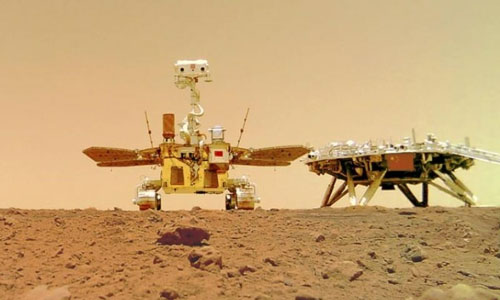Beijing
The dusty, rocky Martian surface and a Chinese rover and lander bearing small national flags were seen in photos released on Friday that the rover took on the red planet.
The four pictures released by the China National Space Administration (CNSA) also show the upper stage of the Zhurong rover and the view from the rover before it rolled off its platform.
Zhurong placed a remote camera about 10 metres from the landing platform, then withdrew to take a group portrait, the CNSA said.
China landed the Tianwen-1 spacecraft carrying the rover on Mars last month after it spent about three months orbiting the red planet.
China is the second country to land and operate a spacecraft on Mars, after the United States.
The orbiter and lander both display small Chinese flags and the lander has outlines of the mascots for the 2022 Beijing Winter Olympics and Paralympics.
The six-wheeled rover is surveying an area known as Utopia Planitia, especially searching for signs of water or ice that could lend clues as to whether Mars ever sustained life.
At 1.85m in height, Zhurong is significantly smaller than the US’s Perseverance rover which is exploring the planet with a tiny helicopter.
Nasa expects its rover to collect its first sample in July for a return to Earth as early as 2031.
In addition to the Mars mission, China’s ambitious space programme plans to send the first crew to its new space station next week.
The three crew members plan to stay for three months on the Tianhe, or Heavenly Harmony, station, far exceeding the length of any previous Chinese mission.
They will perform spacewalks, construction and maintenance work and carry out science experiments.
Subsequent launches are planned to expand the station, send up supplies and exchange crews.
China has also has brought back lunar samples, the first by any country’s space programme since the 1970s, landed a probe and rover on the moon’s less explored far side.
The rocket that will send the first crew members to live on China’s new orbiting space station has been moved onto the launch pad ahead of its planned blast-off next week.
The three astronauts plan to spend three months on the space station doing spacewalks, construction and maintenance work and science experiments.
The main section of the Tianhe, or Heavenly Harmony, station was launched into orbit on April 29, and a cargo spacecraft sent up last month carried fuel, food and equipment to the station in preparation for the crewed mission.
The Long March-2F Y12 rocket carrying the Shenzhou-12 spaceship was transferred to the launch pad at the Jiuquan Satellite Launch Centre in northwest China on Wednesday, the China Manned Space Engineering Office said in a brief statement. Its tentative launch date is next Wednesday.
The space agency plans a total of 11 launches through the end of next year to deliver two laboratory modules to expand the 70-tonne station, along with supplies and crew members. Next week’s launch will be the third of those, and the first of the four crewed missions planned.
China said in March the astronauts training for the upcoming crewed missions were a mix of space travel veterans and newcomers and included some women.
It has sent 11 astronauts into space to date, all of them pilots from the ruling Communist Party’s military wing, the People’s Liberation Army.
The first Tianhe crew will be all male, though women will be part of future crews on the station, according to Yang Liwei, who orbited Earth in China’s first crewed mission in 2003 and is now an official at the space agency.
The Tianhe builds on experience China gained from operating two experimental space stations earlier in its increasingly ambitious space programme.
Chinese astronauts spent 33 days living on the second of the previous stations, carried out a spacewalk and taught science classes that were beamed down to students across the country.—AP










